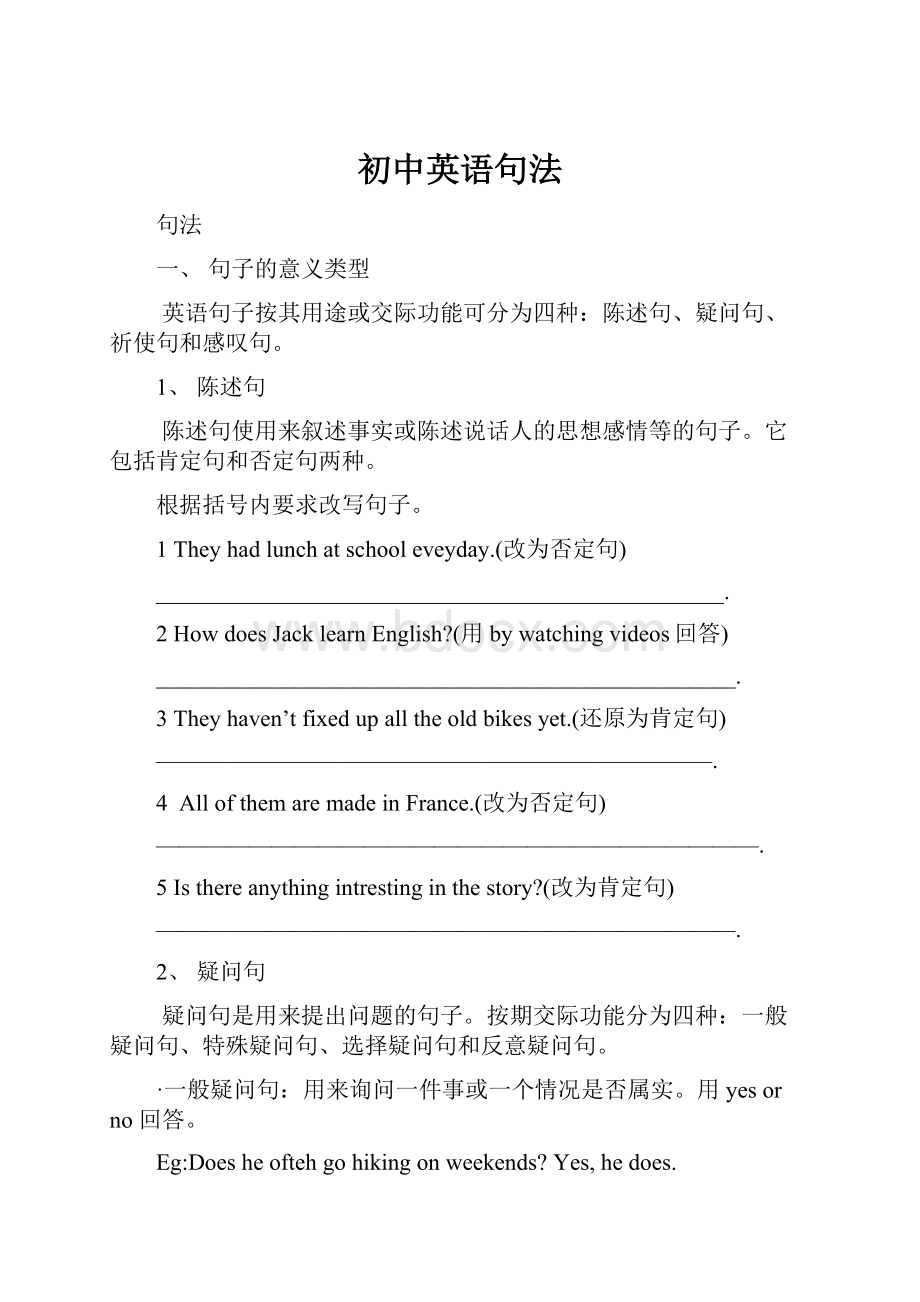初中英语句法.docx
《初中英语句法.docx》由会员分享,可在线阅读,更多相关《初中英语句法.docx(12页珍藏版)》请在冰豆网上搜索。

初中英语句法
句法
一、句子的意义类型
英语句子按其用途或交际功能可分为四种:
陈述句、疑问句、祈使句和感叹句。
1、陈述句
陈述句使用来叙述事实或陈述说话人的思想感情等的句子。
它包括肯定句和否定句两种。
根据括号内要求改写句子。
1Theyhadlunchatschooleveyday.(改为否定句)
_________________________________________________.
2HowdoesJacklearnEnglish?
(用bywatchingvideos回答)
__________________________________________________.
3Theyhaven’tfixedupalltheoldbikesyet.(还原为肯定句)
————————————————————————.
4AllofthemaremadeinFrance.(改为否定句)
——————————————————————————.
5Isthereanythingintrestinginthestory?
(改为肯定句)
—————————————————————————.
2、疑问句
疑问句是用来提出问题的句子。
按期交际功能分为四种:
一般疑问句、特殊疑问句、选择疑问句和反意疑问句。
·一般疑问句:
用来询问一件事或一个情况是否属实。
用yesorno回答。
Eg:
Doesheoftehgohikingonweekends?
Yes,hedoes.
Arethereanypublicrestroomsnearhere?
No,therearen’t.
·特殊疑问句:
用疑问代词或疑问副词引导的疑问句。
一般不能用yesorno回答,回答要说明具体内容。
Eg:
Wherehaveyoubeenthesedays?
/WhatcanIdoforyou?
·选择疑问句:
从并列的两种或两种以上的情况中选择一种作答。
它的形式是“一般疑问句+or+供选择部分”。
回答时不能用yesorno,只能从中选择一种来作答。
Eg;:
—DoyouwanttojointhechessclubortheEnglishclub?
—Englishclub.
—Isthegirloutgoingorquiet?
—She’squiet.
·反意疑问句:
表示提问者有一定的主见,但没有把握,需要对方来证实;或是用反问来加强语气。
它由两部分组成,前一部分是对事情的陈述,后一部分是简短的提问。
如果陈述部分是肯定,则后一部分用否定;如果陈述部分是否定,则后一部分用肯定。
两部分的人称和时态要一致。
Eg:
Hewasborninasmalltown,wasn’the?
Theydidn’tvisitthefamousuniversitylastyear,didthey?
Hehashands,hasn’the?
(他有手,不是吗?
)
Asareporter,hehastoreporttheaccidentintime,doesn’the?
(作为记者,他的及时报道此事件,不是吗?
)
疑问句专项练习
1、Mikehadnothingforbreakfast,______________?
A.hadn’theB.didheC.dian’the
2、—_______isthis?
—Thisismyfriend,John.
A.WhatB.WhoC.Which
3、Whichissmaller,thesun_______themoon?
A.andB.butC.or
4.—Shedidn’tcometoschoollastweek,didshe?
—________,toughshewasnotfeelingverywell.
A.No,shedidn’tB.No,shedid.C.Yes,shedid.
5.—________doyougotoBeijing?
—I’veneverbeenthere.
A.HowoftenB.HowfarC.Howlong
祈使句
祈使句用来表示请求、命令和建议。
祈使句的主语省略,谓语动词只用原形。
否定句在动词前叫don’t.例如:
Sitdown,please./Let’sgoandplaywithhim./Don'tshoutather./Whynotrun!
祈使句专项练习
1、_______lateforthemeeting.
A.NottobeB.NotbeC.Don’tbe
2、Don’tforgettoposttheletterforme,_______?
A.willyouB.shallIC.doyou
3、_________,oryou’llmisstheearlybus.
A.BeingquickB.BequickC.Quick
4.Whydon’twestayathomeor_______tothemovies!
A.togoB.goingC.go
感叹句
感叹句是用来表示强烈感情的句子。
其基本形式为:
How+(adj./adv.)+主语+谓语如:
Howbeautifultheflowersare!
What+(a/an)+adj.+s单数n./不可数n.+(主语+谓语)如:
Whatacutekid!
/Whatabadluck!
What+adj.+复数n.+主语+谓语如:
Whatgoodstudentstheyare!
感叹句专项练习
1、______thegirlissinging!
A.HowbeautifulB.HowbeautifullyC.Whatabeautiful
2.Howcareful________!
A.thegirlisB.isthegirlC.thegirlsheis
3.________storyitis!
A.WhatinterestingB.WhataninterestingC.Howinteresting
4.________theweatheris!
A.WhatafineB.HowfineC.Whatfine
5.________goodtimewehadatthepartylastnight!
A.WhatB.HowC.Whata
二、句子的结构类型
从句子的结构来分,英语句子可分为简单句、并列句和复合句。
1、简单句
只有一个主语(或并列主语)和一个谓语(或并列谓语)的句子。
有五种基本结构:
1主语+谓语(不及物V.)(+状语)Eg:
I’mgoingnextweek.
2主语+连系V.+表语Eg:
Theyarestillalive.
3主语+谓语(及物V.)+宾语Eg:
Thebarberiscuttingmyhair.
4主语+谓语(及物V.)+间接宾语+直接宾语Eg:
Hetoldmethenews.
5主语+谓语(及物V.)+宾语+宾语补足语Eg:
Ifoundthedooropen.
2、并列句
用and,or,but,notonly…butalso等连词连接起来的两个或两个以上简单句叫并列句。
并列句的结构:
简单句+连接词+简单句
Eg:
NowIamenjoyinglearningEnglishandIgotanAthisterm.
Sheisveryoldbutsheisingoodhealth.
Wemusthurry,orwe’llbelateforschool.
Jimnotonlywrotetomelastweekbutalsocametoseemeyesterday.
并列句专项练习
()1、Timegoesby,________goodfriendshipsmaybelost.
A.andB.orC.but
()2、Tomworksveryhard,________hisfamilyisstillverypoor.
A.butB.soC.and
()3、Perhapstheysaidsomethingyoudidn’tlike,_____youfelttheywereunfamiliar.
A.butB.andC.so
()4、Hurryup,________you’llmisstheearlybus.
A.butB.andC.so
()5、Hewasnotinterestedinstuding,_________heoftengotintotroublewiththepolice.
A.butB.andC.so
3、复合句
复合句是由一个主句和一个或一个以上的从句构成的句子。
主句是句子的主体,从句在句子中充当一个句子成分充当宾语的从句叫宾语从句;充当状语的从句,叫状语从句;充当定语的从句,叫定语从句。
从句通常要用一个词来引导,这个词叫引导词,如:
what,who,where,when,if,wheter,while,before,after.
复合句的结构:
主语+引导词+从句
⑴宾语从句
由一个句子来充当宾语,叫宾语从句。
宾语从句的语序:
永远是陈述句语序(即从句的主语在前,谓语在后)
宾语从句的人称:
随合理的逻辑自然变化。
如:
Shesaid,“Iammuchbetterthanbefore.”→Shesaidshewasmuchbetterthanbefore.
宾语从句的引导词:
·如果宾语从句是由陈述句转化而来,要用连词that引导,that可省略。
Eg:
Hesaid(that)Iwaslazy.
·如果宾语从句是从一般疑问句变化而来,要用连词if或wether.Eg:
Heaskedif(wether)wecouldhelphim.
·如果宾语从句是从特殊疑问句变化而来,连词就用特殊疑问词,如:
when,where,why,who,ehose,which,how.
Eg:
Couldyoupleasetellmewheretherestroomsare?
注意:
引导词when和if在引导宾语从句和状语从句时,后面的时态有差别。
在状语从句中when的意思是“当…时候”;在宾语从句中,when表“何时”。
If也一样,在状语从句中译为“如果,假如”;在宾语从句中,译为“是否。
如:
PleaseletmeknowwhenAnncomesback.(状语从句;when当…时候)
IwanttoknowwhenAnnwillcomeback.(宾语从句;When表何时)
Idon’tknowwhenhewillcomeback.Butwhenhecomesback,I’llletyouknow.
(第一个when在宾从中,表“何时”;第二个when在状从中,表“当…时候”)
Idon’tknowifshewillcomeback.Butifshecomesback,I’llletyoukmow.
(第一个if在宾从中,表“是否”;第二个if在状从中,表“如果”)
宾语从句的时态:
·主句的谓语动词是一般现在时或一般将来时,从句的谓语动词可以是任何需要的时态。
·主句的谓语动词是一般过去时,从句的谓语动词用表示过去的时态。
Eg:
Sheaddedthathavingconversationswithfriendswasnothelpfulatall.
·当宾语从句表示真理、科学原理及自然现象时,从句的谓语不受主句制约,用一般现在时。
如:
Theteachertoldusthatlighttravelsfasterthansound.
宾语从句专项练习
()1.Hetoldher________shecouldcatchtheearlybus.
A.whichB.whereC.what
()2.Mrs.Greenaskedme_______Iwouldgowithher.
A.thatB.whichC.why
()3.Canyoutellmewhy_______yesterday.
A.youdidn’tcomeB.don’tyoucomeC.didn'tyoucome
()4.Hesaidthathisboss______Chengdu.SoIcan’tseehimatthemoment.
A.hadbeentoB.hadgonetoC.hasgoneto
()5.Hesaidthattheearth______aroundthesun.
A.traveledB.willtravelC.travels
(2)、状语从句
由一个句子做状语,叫状语从句。
特点:
状语从句在复合句中起状语作用,修饰主句中的谓语动词、形容词或副词。
状语从句由连词引导,连词在句中不充当句子成分,只起连接的作用。
分类:
根据意义不同,状语从句分为:
时间状语从句、地点状语从句、原因状语从句、目的状语从句、方式状语从句、条件状语从句、结果状语从句、让步状语从句、比较状语从句。
·时间状语从句:
引导词:
when,while,before,bythetime,after,since,as,until,assoonas,whenever等。
A.when引导的时间状语从句表示主句谓语动词的动作与从句谓语动词的动作同时发生,或从句的动作发生在主句的动作之前。
可表示“一段”时间。
Eg:
ShewastakingawalkwhenIcalledher.
B.while引导时间状语从句强调主句的动作和从句的动作同时发生,意为“在…期间、在…过程中”。
While引导的时间状从只能表示一段时间(同延续性动词连用),不能同非延续性动词连用。
Eg:
Whileshewaswatching,sheheardthebellring.
C.As引导的时间状语从句表示“当…时,一边…一边”,指主句的动作和从句的动作同时发生,既可同延续性动词也可同非延续性动词连用。
Eg:
Isawherasshewasgettingoffthebus.
D.Before,bythetime引导的时间状语从句所表示的动作发生在主句动作之后。
如果强调主句的动作先完成或先发生,则主句谓语要用过去完成时;如不强调动作完成的先后,主句和从句均用一般过去时。
Eg:
Bythetimehegottothestop,thebushadleft./HeworkedinTibetbeforehecamehere.
E.After引导的时间状语从句所表示的动作发生在主句动作之前。
如强调动作的先后,after从句用过去完成时,主句用一般过去时;如不强调动作的先后,而表示连续动作,主句和从句均用一般过去时。
Eg:
AfterIhadfixedupmybike,Iwentbicycling.
·地点状语从句:
由where,wherever引导。
Eg:
Ifollowhimwhereverhegoes.
·条件状语从句:
由if,unless引导。
Eg:
IfIhaveenoughmoney,Iwillbuyacar.
注意:
在条件状语从句中,所说的内容与事实相反,谓语动词要用虚拟语气。
Eg:
IfIwereyou,I’dwearashirt.
Whatwouldyoudoifyouhadamilliondollarsnow.
·比较状语:
从句:
引导词有:
than,the+比较级…the+比较级,as+原级…as,notas/so+原级…as.
Eg:
TomwenttoschollearlierthanKatedid.
Maryrunsasfastasherbrotherdoes.
·原因状语从句:
引导词有:
because,since,as,nowthat.
Eg:
Becausehewasill,hewasabsentyesterday.
SinceMariohasfinishedhomework,hecanleavenow.
·方式状语从句:
引导词有as,asif等。
Eg:
PleasedoasIdo./Hewalksasifheissoold.
·目的状语从句:
引导词有sothat,inorderthat等,目的状语从句的谓语常含有many,might,can,could,should,would(情态动词等)Eg:
HestudiedhardsothathemightpasstheEntranceExams.
·结果状语从句:
引导词so,so…that,such…that等。
Eg:
thetreeissohighthatwecan’treachit./Hestudiedhardsohebecamethetopstudentoftheclass.
·让步状语从句:
引导词though,although,evenif,eventhough,however,whatever,nomatter等。
Eg:
Althoughhehasfailedmanytimes,hedoesn’tgiveuptrying.
Nomatterwhathappens,I’llfollowyoursteps.
状语从句专项练习
1、__________youalwayseattoomuch,youmaybeill.
A.althoughB.Ifc.Why
2、__________itwasright,theystoppedworking.
A.AsB.SoC.Asif
3.Theteacherhadalreadyleft_______Igottohisoffice.
A.beforeB.sinceC.after
4.HefindswatchingEnglishmoviesfrustrating_______peopleinthemspeaktooquikly.
A.asifB.whereC.because
5.Firstofall,itwasn’teasyformetounderstandtheteacher________shetalkedtotheclass.
A.nowthatB.unlessC.when
6.IfI________young,I________soccerlikeyounow.ButI’meightyyearsold.
A.am,willplayB.were,wouldplayC.was,couldplay
定语从句
在复合句中,修饰名词或代词的从句叫做定语从句,被定语从句修饰的名词或代词叫先行词,定语从句必须放在先行词之后。
引导词:
who(指人),that(指人或物),where(指地点),which
That可以指人或物。
Eg:
Ilikepopstarsthatwearreallycoolclothes.
IlikemusicthanIcandanceto.
Who指人。
Eg:
Iprefersingerswhowritetheirownlyrics.
Where指地点。
Eg:
EveryonewantstovisittheplacewhereEinsteinonceworked.
Which:
非限定性定语从句。
非限定性定语从句起补充说明作用,缺少也不会影响全句的理解。
在非限制性定语从句的前面往往有逗号隔开,如
(1)Thehouse,whichIboughtlastyear,hasalovelygarden. 我去年买的的房子带着个漂亮的花园。
(2)Thisnovel,whichIhavereadthreetimes,isverytouching.这本我已经读过三遍的小说很感人。
特殊情况:
只能用that的情况,
1.先行词被all,every,no,any,some,little,much,one修饰时;
2.先行词被theonly,thevery,thesame,thelast修饰时;ThisistheverygooddictionarythatIwanttobuy.
3.先行词被序数词或形容词最高级修饰时;ThesecondforeigncountrythatlexpecttovisitisGreek.
4.先行词是be的表语或therebe的主语时;Thereisabirdthatcanspeak.
5.先行词有人又有物时;Canyourememberthescientistandhistheorythatwehavelearned?
6.当主句是以who或which开头的特殊疑问句时,为避免重复,常用"that".
淘气的娃娃美丽的夏夜可口的松果闷热的天气Whoisthemanthatisstandingthere?
WhichistheT-shirtthatfitsmemost?
7.先行词为everything,all,little,much等不定代词时;eg:
如:
爱(爱人